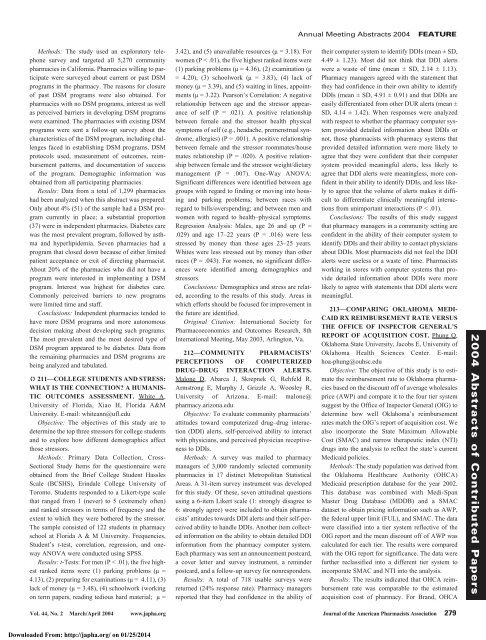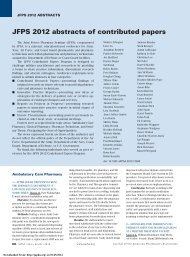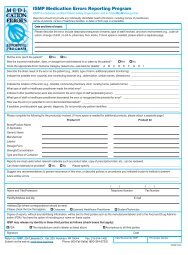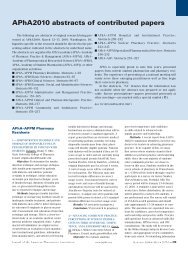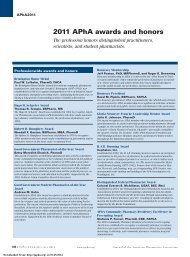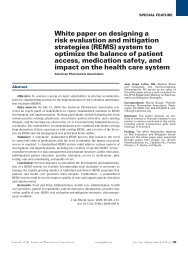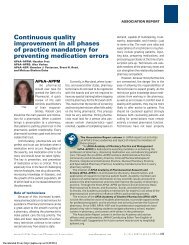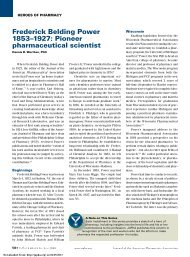Downloaded - Journal of American Pharmacists Association
Downloaded - Journal of American Pharmacists Association
Downloaded - Journal of American Pharmacists Association
Create successful ePaper yourself
Turn your PDF publications into a flip-book with our unique Google optimized e-Paper software.
Annual Meeting Abstracts 2004<br />
FEATURE<br />
Methods: The study used an exploratory telephone<br />
survey and targeted all 5,270 community<br />
pharmacies in California. Pharmacies willing to participate<br />
were surveyed about current or past DSM<br />
programs in the pharmacy. The reasons for closure<br />
<strong>of</strong> past DSM programs were also obtained. For<br />
pharmacies with no DSM programs, interest as well<br />
as perceived barriers in developing DSM programs<br />
were examined. The pharmacies with existing DSM<br />
programs were sent a follow-up survey about the<br />
characteristics <strong>of</strong> the DSM program, including challenges<br />
faced in establishing DSM programs, DSM<br />
protocols used, measurement <strong>of</strong> outcomes, reimbursement<br />
patterns, and documentation <strong>of</strong> success<br />
<strong>of</strong> the program. Demographic information was<br />
obtained from all participating pharmacies.<br />
Results: Data from a total <strong>of</strong> 1,299 pharmacies<br />
had been analyzed when this abstract was prepared.<br />
Only about 4% (51) <strong>of</strong> the sample had a DSM program<br />
currently in place; a substantial proportion<br />
(37) were in independent pharmacies. Diabetes care<br />
was the most prevalent program, followed by asthma<br />
and hyperlipidemia. Seven pharmacies had a<br />
program that closed down because <strong>of</strong> either limited<br />
patient acceptance or exit <strong>of</strong> directing pharmacist.<br />
About 20% <strong>of</strong> the pharmacies who did not have a<br />
program were interested in implementing a DSM<br />
program. Interest was highest for diabetes care.<br />
Commonly perceived barriers to new programs<br />
were limited time and staff.<br />
Conclusions: Independent pharmacies tended to<br />
have more DSM programs and more autonomous<br />
decision making about developing such programs.<br />
The most prevalent and the most desired type <strong>of</strong><br />
DSM program appeared to be diabetes. Data from<br />
the remaining pharmacies and DSM programs are<br />
being analyzed and tabulated.<br />
211—COLLEGE STUDENTS AND STRESS:<br />
WHAT IS THE CONNECTION? A HUMANIS-<br />
TIC OUTCOMES ASSESSMENT. White A,<br />
University <strong>of</strong> Florida, Xiao H, Florida A&M<br />
University. E-mail: whiteann@ufl.edu<br />
Objective: The objectives <strong>of</strong> this study are to<br />
determine the top three stressors for college students<br />
and to explore how different demographics affect<br />
those stressors.<br />
Methods: Primary Data Collection, Cross-<br />
Sectional Study Items for the questionnaire were<br />
obtained from the Brief College Student Hassles<br />
Scale (BCSHS), Erindale College University <strong>of</strong><br />
Toronto. Students responded to a Likert-type scale<br />
that ranged from 1 (never) to 5 (extremely <strong>of</strong>ten)<br />
and ranked stressors in terms <strong>of</strong> frequency and the<br />
extent to which they were bothered by the stressor.<br />
The sample consisted <strong>of</strong> 122 students in pharmacy<br />
school at Florida A & M University. Frequencies,<br />
Student’s t-test, correlation, regression, and oneway<br />
ANOVA were conducted using SPSS.<br />
Results: t-Tests: For men (P < .01), the five highest<br />
ranked items were (1) parking problems (µ =<br />
4.13), (2) preparing for examinations (µ = 4.11), (3)<br />
lack <strong>of</strong> money (µ = 3.48), (4) schoolwork (working<br />
on term papers, reading tedious hard material; µ =<br />
3.42), and (5) unavailable resources (µ = 3.18). For<br />
women (P < .01), the five highest ranked items were<br />
(1) parking problems (µ = 4.36), (2) examination (µ<br />
= 4.20), (3) schoolwork (µ = 3.83), (4) lack <strong>of</strong><br />
money (µ = 3.39), and (5) waiting in lines, appointments<br />
(µ = 3.22). Pearson’s Correlation: A negative<br />
relationship between age and the stressor appearance<br />
<strong>of</strong> self (P = .021). A positive relationship<br />
between female and the stressor health physical<br />
symptoms <strong>of</strong> self (e.g., headache, premenstrual syndrome,<br />
allergies) (P = .001). A positive relationship<br />
between female and the stressor roommates/house<br />
mates relationship (P = .020). A positive relationship<br />
between female and the stressor weight/dietary<br />
management (P = .007). One-Way ANOVA:<br />
Significant differences were identified between age<br />
groups with regard to finding or moving into housing<br />
and parking problems; between races with<br />
regard to bills/overspending; and between men and<br />
women with regard to health–physical symptoms.<br />
Regression Analysis: Males, age 26 and up (P =<br />
.029) and age 17–22 years (P = .016) were less<br />
stressed by money than those ages 23–25 years.<br />
Whites were less stressed out by money than other<br />
races (P = .043). For women, no significant differences<br />
were identified among demographics and<br />
stressors.<br />
Conclusions: Demographics and stress are related,<br />
according to the results <strong>of</strong> this study. Areas in<br />
which efforts should be focused for improvement in<br />
the future are identified.<br />
Original Citation: International Society for<br />
Pharmacoeconomics and Outcomes Research, 8th<br />
International Meeting, May 2003, Arlington, Va.<br />
212—COMMUNITY PHARMACISTS’<br />
PERCEPTIONS OF COMPUTERIZED<br />
DRUG–DRUG INTERACTION ALERTS.<br />
Malone D, Abarca J, Skrepnek G, Rehfeld R,<br />
Armstrong E, Murphy J, Grizzle A, Woosley R,<br />
University <strong>of</strong> Arizona. E-mail: malone@<br />
pharmacy.arizona.edu<br />
Objective: To evaluate community pharmacists’<br />
attitudes toward computerized drug–drug interaction<br />
(DDI) alerts, self-perceived ability to interact<br />
with physicians, and perceived physician receptiveness<br />
to DDIs.<br />
Methods: A survey was mailed to pharmacy<br />
managers <strong>of</strong> 3,000 randomly selected community<br />
pharmacies in 17 distinct Metropolitan Statistical<br />
Areas. A 31-item survey instrument was developed<br />
for this study. Of these, seven attitudinal questions<br />
using a 6-item Likert scale (1: strongly disagree to<br />
6: strongly agree) were included to obtain pharmacists’<br />
attitudes towards DDI alerts and their self-perceived<br />
ability to handle DDIs. Another item collected<br />
information on the ability to obtain detailed DDI<br />
information from the pharmacy computer system.<br />
Each pharmacy was sent an announcement postcard,<br />
a cover letter and survey instrument, a reminder<br />
postcard, and a follow-up survey for nonresponders.<br />
Results: A total <strong>of</strong> 718 usable surveys were<br />
returned (24% response rate). Pharmacy managers<br />
reported that they had confidence in the ability <strong>of</strong><br />
their computer system to identify DDIs (mean ± SD,<br />
4.49 ± 1.23). Most did not think that DDI alerts<br />
were a waste <strong>of</strong> time (mean ± SD, 2.14 ± 1.13).<br />
Pharmacy managers agreed with the statement that<br />
they had confidence in their own ability to identify<br />
DDIs (mean ± SD, 4.91 ± 0.91) and that DDIs are<br />
easily differentiated from other DUR alerts (mean ±<br />
SD, 4.14 ± 1.42). When responses were analyzed<br />
with respect to whether the pharmacy computer system<br />
provided detailed information about DDIs or<br />
not, those pharmacists with pharmacy systems that<br />
provided detailed information were more likely to<br />
agree that they were confident that their computer<br />
system provided meaningful alerts, less likely to<br />
agree that DDI alerts were meaningless, more confident<br />
in their ability to identify DDIs, and less likely<br />
to agree that the volume <strong>of</strong> alerts makes it difficult<br />
to differentiate clinically meaningful interactions<br />
from unimportant interactions (P < .01).<br />
Conclusions: The results <strong>of</strong> this study suggest<br />
that pharmacy managers in a community setting are<br />
confident in the ability <strong>of</strong> their computer system to<br />
identify DDIs and their ability to contact physicians<br />
about DDIs. Most pharmacists did not feel the DDI<br />
alerts were useless or a waste <strong>of</strong> time. <strong>Pharmacists</strong><br />
working in stores with computer systems that provide<br />
detailed information about DDIs were more<br />
likely to agree with statements that DDI alerts were<br />
meaningful.<br />
213—COMPARING OKLAHOMA MEDI-<br />
CAID RX REIMBURSEMENT RATE VERSUS<br />
THE OFFICE OF INSPECTOR GENERAL’S<br />
REPORT OF ACQUISITION COST. Phung Q,<br />
Oklahoma State University, Jacobs E, University <strong>of</strong><br />
Oklahoma Health Sciences Center. E-mail:<br />
hoa-phung@ouhsc.edu<br />
Objective: The objective <strong>of</strong> this study is to estimate<br />
the reimbursement rate to Oklahoma pharmacies<br />
based on the discount <strong>of</strong>f <strong>of</strong> average wholesales<br />
price (AWP) and compare it to the four tier system<br />
suggest by the Office <strong>of</strong> Inspector General (OIG) to<br />
determine how well Oklahoma’s reimbursement<br />
rates match the OIG’s report <strong>of</strong> acquisition cost. We<br />
also incorporate the State Maximum Allowable<br />
Cost (SMAC) and narrow therapeutic index (NTI)<br />
drugs into the analysis to reflect the state’s current<br />
Medicaid policies.<br />
Methods: The study population was derived from<br />
the Oklahoma Healthcare Authority (OHCA)<br />
Medicaid prescription database for the year 2002.<br />
This database was combined with Medi-Span<br />
Master Drug Database (MDDB) and a SMAC<br />
dataset to obtain pricing information such as AWP,<br />
the federal upper limit (FUL), and SMAC. The data<br />
were classified into a tier system reflective <strong>of</strong> the<br />
OIG report and the mean discount <strong>of</strong>f <strong>of</strong> AWP was<br />
calculated for each tier. The results were compared<br />
with the OIG report for significance. The data were<br />
further reclassified into a different tier system to<br />
incorporate SMAC and NTI into the analysis.<br />
Results: The results indicated that OHCA reimbursement<br />
rate was comparable to the estimated<br />
acquisition cost <strong>of</strong> pharmacy. For Brand, OHCA<br />
2004 Abstracts <strong>of</strong> Contributed Papers<br />
Vol. 44, No. 2 March/April 2004 www.japha.org <strong>Journal</strong> <strong>of</strong> the <strong>American</strong> <strong>Pharmacists</strong> <strong>Association</strong> 279<br />
<strong>Downloaded</strong> From: http://japha.org/ on 01/25/2014


